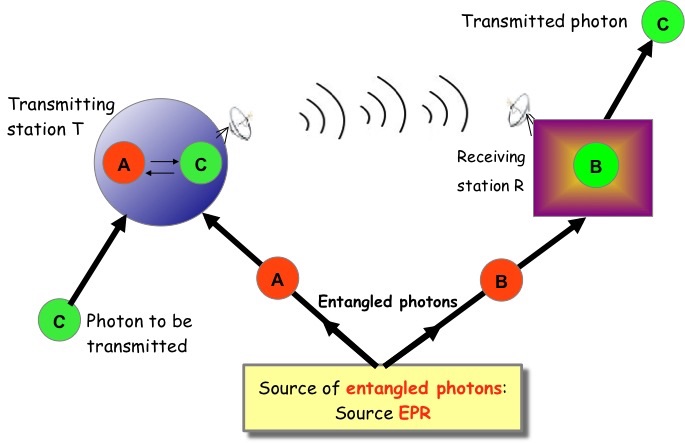
QUANTUM TELEPORTATION PROCESS

The figure shows a schematic Quantum Teleportation process; a short description of this process can be summarized as follows:
Production of a pair of entangled photons A e B by an appropriate device.
Sending of the entangled photons A e B respectively to the transmitting station T and to the receiving station R.
Sending of the photon C, of which you want to teleport the state of polarization, to the transmitting station T.
Interaction, at the start station T, between the photons A and C and measure on the combined system.
Simultaneous change, during the measurement, of the polarization state of the photon B, at the R station.
Communication to the R station, by the traditional media (e.g.: telephone call), of the result of the measurement on the photon A and the photon C (4 results are possible).
Change of the status of photon B based on the information communicated.
Result: Quantum teleportation of the photon C, this means that a photon with the same polarization state
of the photon C has been obtained without any measurement on it.
MORE DETAILED DESCRIPTION OF THE QUANTUM TELEPORTATION PROCESS
Amanda and Bert intend to teleport the photon C. Amanda is at the T station and Bert is at the R station.
At the beginning each receives one photon of an entangled pair: Amanda receives the photon A and Bert receives the photon B. Instead of carrying out a measure on the photons, they keep their photon without disturbing the entangled state.
Amanda receives a third photon C that she wants to teleport to Bert. Amanda in practice, without knowing the polarization state of the photon C, wants that Bert has a photon with the same polarization of the photon C. It is important to notice that Amanda cannot simply measure the polarization state of the photon C, and then communicate the result to Bert because, for the uncertainty principle, the measure couldn't accurately reproduce the original state of the photon.
To teleport the photon C, Amanda makes A and C to interact and performs a measurement on the system, without determining, in absolute terms, the individual polarizations of the two photons.
The measurement can give 1 of 4 possible results. In technical terms, a joint measurement of this type is called “Bell's state measurement” and it has a particular effect: “it induces instantly a change in Bert's photon, correlating it to the result of the measurement performed by Amanda and to the state that the photon C originally had”.
To complete the teleportation, Amanda has to send a message to Bert by the conventional methods (a phone call or a written note).
After receiving this message, Bert, if necessary, may transform his photon B in order to make an exact replica of the original photon C. The transformation that Bert should apply depends on the result of the measurement of Amanda.
Which of the four possible results Amanda gets, is due to chance. Therefore, Bert does not know how to modify his photon until he receives from Amanda the result of the measurement. After this transformation Bert's photon is in the same state of the photon C.
Then, what has been transported is not the photon but its polarization state or, generally, its quantum state. However, since quantum state is a peculiar characteristic of a particle, we can say that to teleport a quantum state is like teleport the particle.
It's important to observe that the measurement that Amanda made, connects the photon A to the photon C. So the photon C loses all the “memory” of its original state. Therefore, the original state of the C photon, after the measurement, disappears from the place where Amanda is. The result of the measurement of Amanda, being totally random, doesn't say anything about the quantum state. In this way, the process bypasses the Heisenberg’s principle which doesn't allow full determination of the state of a particle but allows the teleport of the state, provided that Amanda doesn't try to know what it is.
The state of the C photon has been transferred without Amanda and Bert had any knowledge of it. In addition, the teleported quantum information doesn't travel physically. What is transferred, essentially, is just the message on the result of the measurement of Amanda that says to Bert how he has to modify his photon, without any indication on the state of the C photon. In one of the four cases, the measurement of Amanda is lucky and Bert's photon becomes immediately a replica of the original. In this case, it might seem that the information travels instantly from Amanda to Bert, breaking the limit imposed by Einstein. It is not so, in fact Bert has no way of knowing that his photon is already a replica of the original. Only when he learns the result of the measurement of the Bell's state, performed by Amanda and transmitted to him by the classical information, he can take advantage of the information about the teleported quantum state.
CONCLUSIONS
We are still far from the teleportation of a large object. The main problems are:
two entangled objects of the same type are required;
the object that should be teleported and the entangled objects must be sufficiently isolated from the environment. If any information is exchanged with the environment, through accidental interaction, the quantum state of the object degrades in a process called “decoherence”.
It is hard to imagine how you can achieve an absolute isolation for a body of macroscopic dimensions and even more for a human being because he breathes air and exchanges heat with the outside world. But, who can predict the future developments?
The technology that can teleport states of individual atoms has been reached, as shown by the group led by Serge Haroche of the Ecole Normale Supérieure in Paris, which has produced entangled atoms.